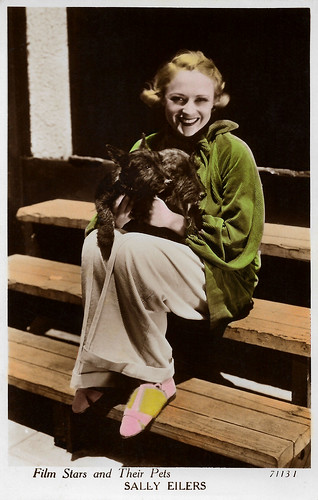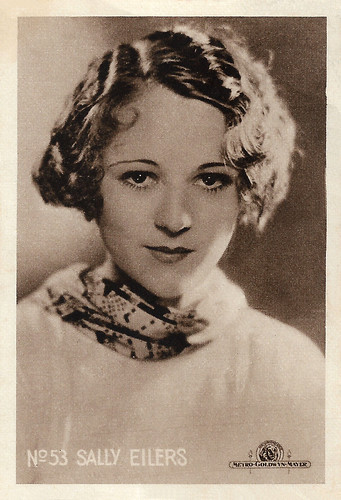American actress Sally Eilers (1908-1978) was a popular Hollywood star in the early-1930s. She was tagged 'the most beautiful girl in movies'.

German cigarette card by Ross Verlag in the 'Künstler im Film' series for Zigarettenfabrik Monopol, Dresden, Serie 1, image 116 (of 200). Photo: Fox-Film.

British postcard by Valentine's in the Film Stars and Their Pets series, no. 71131. Photo: Fox.

British 'Real Photograph' postcard in the Autograph Series, London, no. A 30.

German cigarette card by Ross Verlag in the 'Künstler im Film' series for Zigarettenfabrik Monopol, Dresden, Serie 1, image 104 (of 200). Photo: 20th Century Fox.
Dorothea Sally Eilers was born in New York City in 1908 to a Jewish-American mother, Paula (née Schoenberger), and an Irish-American father, Hio Peter Eilers, who was an inventor.
She was educated in Los Angeles, California, and went into films because so many of her friends were in pictures. She studied for the stage, specialising in dancing. Her first try was a failure so she tried typing but then went back into pictures and succeeded.
She made her film debut with an uncredited bit part in the comedy The Red Mill (Roscoe Arbuckle as William Goodrich, 1927) with Marion Davies. After several minor roles as an extra, she found work with Mack Sennett. In 1927, he offered her a role in The Good-Bye Kiss (Mack Sennett, 1928), a rare dramatic feature for the studio.
Either Sennett or Florenz Ziegfeld Jr. (depending on which version of the story is to be believed) tagged Sally with the publicity line 'the most beautiful girl in movies'. In 1928 she was voted as one of the WAMPAS Baby Stars, a yearly list of young actresses nominated by exhibitors based on their box-office appeal.
The vivacious former brunette (quickly transformed by Hollywood into a blonde) spent her apprenticeship as a leading actress co-starring with her future husband Hoot Gibson in the Western The Long, Long Trail (Arthur Rosson, 1929) and with Buster Keaton in the comedy Doughboys (Edward Sedgwick, 1930).

Belgian postcard by S.A. Cacao et Chocolat Kivou, Vilvoorde / N.V. Cacao en Chocolade Kivou, Vilvoorde. Photo: Metro-Goldwyn-Mayer.

British postcard in the Picturegoer Series, London, no. 558.

British postcard in the Film Weekly Series, no. 1.

British Real Photograph postcard, no. 27. Photo: Fox Films.
Sally Eilers became a popular figure in the early-1930s Hollywood, known for her high spirits and vivacity. In 1931, director Frank Borzage cast her in the depression-era film Bad Girl (1931).
I.S. Mowis at IMDb: "What could have been maudlin melodrama, was enlivened by excellent direction and some snappy dialogue (winning Academy Awards for both direction and screenplay) and elicited from Sally Eilers in the title role (as 'Dot Haley') the best performance of her career. There were to be other films of note: Reducing (1931) with Marie Dressler, the original State Fair (1933) with Will Rogers (with Sally playing a 'carnie') and Sailor's Luck (1933), with her Bad Girl (1931) co-star James Dunn, where a review described her performance as 'highly satisfactory'."
Her other films were mostly comedies and crime melodramas such as the crime film Quick Millions (Rowland Browne, 1931) with Spencer Tracy and the sparkling mystery comedy Remember Last Night? (James Whale, 1935).
She was married for a short time to cowboy actor Hoot Gibson, though the marriage ended in divorce in 1933. By the end of the decade, her popularity had waned, and her subsequent film appearances were few. She made her final film appearance in 1950.
She was married four times. With her second husband, Harry Joe Brown, she resided in a mansion located in Beverly Hills. They had a son, screenwriter Harry Joe Brown Jr. Her other two husbands were Howard Barney and director Hollingsworth Morse. During her final years, Sally Eilers suffered poor health and died from a heart attack in 1978, in Woodland Hills, California. She was 69.

British postcard by Milton, no. 27A. Photo: Universal Pictures.

British postcard in the Film Partners Series, London, no. P 12. Photo: Sally Eilers and James Dunn in Bad Girl (Frank Borzage, 1931).

Dutch postcard, no. 25. Photo: Hal Phyfe / Fox Film.

British postcard by Valentine's in the Film Stars and Their Pets series, no. 5843 I. Photo: Fox. Sent by mail in 1934.

Dutch-Belgian collectors card by N.V. London Caramel Works, Breda (Holland) / Esschen (België), no. 53 (of 120). Photo: Metro-Goldwyn-Mayer.
Sources: I.S. Mowis (IMDb), Wikipedia, and IMDb.
This post was last updated on 10 February 2024.

German cigarette card by Ross Verlag in the 'Künstler im Film' series for Zigarettenfabrik Monopol, Dresden, Serie 1, image 116 (of 200). Photo: Fox-Film.

British postcard by Valentine's in the Film Stars and Their Pets series, no. 71131. Photo: Fox.

British 'Real Photograph' postcard in the Autograph Series, London, no. A 30.

German cigarette card by Ross Verlag in the 'Künstler im Film' series for Zigarettenfabrik Monopol, Dresden, Serie 1, image 104 (of 200). Photo: 20th Century Fox.
The vivacious former brunette
Dorothea Sally Eilers was born in New York City in 1908 to a Jewish-American mother, Paula (née Schoenberger), and an Irish-American father, Hio Peter Eilers, who was an inventor.
She was educated in Los Angeles, California, and went into films because so many of her friends were in pictures. She studied for the stage, specialising in dancing. Her first try was a failure so she tried typing but then went back into pictures and succeeded.
She made her film debut with an uncredited bit part in the comedy The Red Mill (Roscoe Arbuckle as William Goodrich, 1927) with Marion Davies. After several minor roles as an extra, she found work with Mack Sennett. In 1927, he offered her a role in The Good-Bye Kiss (Mack Sennett, 1928), a rare dramatic feature for the studio.
Either Sennett or Florenz Ziegfeld Jr. (depending on which version of the story is to be believed) tagged Sally with the publicity line 'the most beautiful girl in movies'. In 1928 she was voted as one of the WAMPAS Baby Stars, a yearly list of young actresses nominated by exhibitors based on their box-office appeal.
The vivacious former brunette (quickly transformed by Hollywood into a blonde) spent her apprenticeship as a leading actress co-starring with her future husband Hoot Gibson in the Western The Long, Long Trail (Arthur Rosson, 1929) and with Buster Keaton in the comedy Doughboys (Edward Sedgwick, 1930).

Belgian postcard by S.A. Cacao et Chocolat Kivou, Vilvoorde / N.V. Cacao en Chocolade Kivou, Vilvoorde. Photo: Metro-Goldwyn-Mayer.

British postcard in the Picturegoer Series, London, no. 558.

British postcard in the Film Weekly Series, no. 1.

British Real Photograph postcard, no. 27. Photo: Fox Films.
Known for her high spirits and vivacity
Sally Eilers became a popular figure in the early-1930s Hollywood, known for her high spirits and vivacity. In 1931, director Frank Borzage cast her in the depression-era film Bad Girl (1931).
I.S. Mowis at IMDb: "What could have been maudlin melodrama, was enlivened by excellent direction and some snappy dialogue (winning Academy Awards for both direction and screenplay) and elicited from Sally Eilers in the title role (as 'Dot Haley') the best performance of her career. There were to be other films of note: Reducing (1931) with Marie Dressler, the original State Fair (1933) with Will Rogers (with Sally playing a 'carnie') and Sailor's Luck (1933), with her Bad Girl (1931) co-star James Dunn, where a review described her performance as 'highly satisfactory'."
Her other films were mostly comedies and crime melodramas such as the crime film Quick Millions (Rowland Browne, 1931) with Spencer Tracy and the sparkling mystery comedy Remember Last Night? (James Whale, 1935).
She was married for a short time to cowboy actor Hoot Gibson, though the marriage ended in divorce in 1933. By the end of the decade, her popularity had waned, and her subsequent film appearances were few. She made her final film appearance in 1950.
She was married four times. With her second husband, Harry Joe Brown, she resided in a mansion located in Beverly Hills. They had a son, screenwriter Harry Joe Brown Jr. Her other two husbands were Howard Barney and director Hollingsworth Morse. During her final years, Sally Eilers suffered poor health and died from a heart attack in 1978, in Woodland Hills, California. She was 69.

British postcard by Milton, no. 27A. Photo: Universal Pictures.

British postcard in the Film Partners Series, London, no. P 12. Photo: Sally Eilers and James Dunn in Bad Girl (Frank Borzage, 1931).

Dutch postcard, no. 25. Photo: Hal Phyfe / Fox Film.

British postcard by Valentine's in the Film Stars and Their Pets series, no. 5843 I. Photo: Fox. Sent by mail in 1934.

Dutch-Belgian collectors card by N.V. London Caramel Works, Breda (Holland) / Esschen (België), no. 53 (of 120). Photo: Metro-Goldwyn-Mayer.
Sources: I.S. Mowis (IMDb), Wikipedia, and IMDb.
This post was last updated on 10 February 2024.
No comments:
Post a Comment